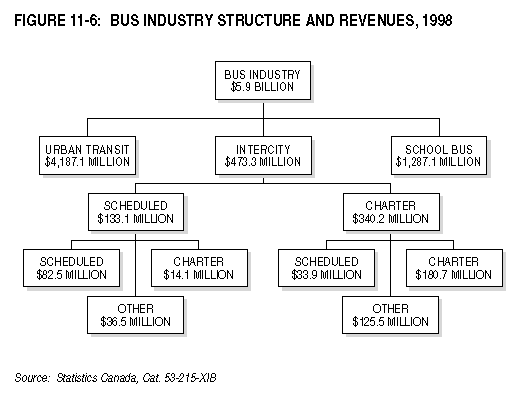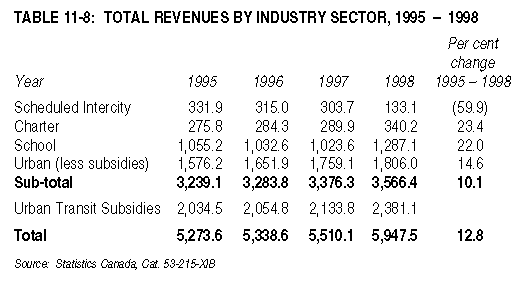11
STRUCTURE OF THE TRANSPORTATION INDUSTRY
Bus Transportation Industry
The Canadian bus industry includes three main business lines:
intercity bus services, urban transit services and school bus
services. Intercity bus services can be further broken down into
scheduled and charter services. Charter services include airport
shuttle services, services offered under contract, sightseeing
services (urban or interurban), and convention services. Canadian
bus transportation companies very seldom offer only one type of
bus service. More often than not, they offer more services in
an attempt to maximize the revenue-generating activities of their
bus fleet.
For the purposes of classification, each firm has been listed
under the line of business that generates more than half of its
revenues.
Figure 11-6 shows the industry structure and revenues of the
bus industry in Canada in 1998. This data includes almost $2.4
billion in operating and capital subsidies to urban transit operators.
Table 11-7 summarizes revenues by sources of revenue for the same
year.


The Canadian bus industry experienced an overall 10.1 per
cent increase in revenues (excluding urban transit subsidies)
between 1995 and 1998. Within the different sectors, reported
revenues were subject to variations during that period. They were
caused, in part, by consolidated financial reporting resulting
from mergers and acquisitions, as well as by a new industrial
classification system implemented by Statistics Canada -- North
American Industry Classification System (NAICS).Note 6
Table 11-8 shows the total revenues of the bus industry, by
sector, for the 1995 - 1998 period. It also shows the percentage
change in revenues from 1995 to 1998.

Major Bus Events in 1999
Legislative and Regulatory Changes
Review of the Motor Vehicle Transport Act, 1987
In March 1999, the Minister proposed amendments to the federal
Motor Vehicle Transport Act 1987, including deregulation
of the extra-provincial bus industry through a two-stage
process. In the first stage, the proposed amendments would deregulate
interprovincial and international bus services; in the second
stage, all bus services would be deregulated.
This proposal followed several years of discussions with the
provinces and industry stakeholders on the future of bus regulation
in Canada. The MVTA allows each province and territory to decide
whether to apply economic controls to extra-provincial bus carriers
operating to and from its jurisdiction even though these carriers
fall under federal jurisdiction. The federal government's position
has always been to seek a consensus of government and industry
in making changes to the MVTA.
In September 1999, the Minister announced that, in the absense
of consensus on the future of extra-provincial bus regulation
in Canada, he would not proceed with proposed amendments to deregulate
the bus industry. Instead, he would refer the issue of bus regulation
in Canada to a Parliamentary committee for examination.
Industry Events
Some members of the Canadian bus industry have been quite proactive
in leading the trend, noticeable in North America and elsewhere,
toward consolidation in bus operations.
In March 1999, the shareholders of Greyhound Lines Inc. of
Dallas, Texas, approved a merger with Laidlaw Inc. of Burlington,
Ontario. As Laidlaw already owned Greyhound Canada and several
other Canadian intercity bus operations, it thus became the largest
intercity bus operator in North America. Laidlaw's school bus
operations, however, continue to yield the majority of its operating
revenues.
In June 1999, Stagecoach Holdings Inc. of Perth, Scotland,
took control of Coach USA, of Houston, Texas, through a merger
agreement. Coach USA included three Canadian bus operations: Trentway-Wagar
(Peterborough, Ontario), Autocar Connaisseur (Montreal) and Erie Coach
(London, Ontario).
Bus Services
Intercity Bus Service
While intercity bus services account for the bulk of long-distance
bus transportation, they represent the smallest segment of the
industry in terms of revenues. Intercity services can be sub-divided
into scheduled intercity operations and charter services. Charter
services include airport, sightseeing and tour services. Most
of the large carriers offering scheduled intercity bus services
also do charter business.
Intercity services exclusively within a province come under
provincial responsibility. Most school bus and urban transit operators
in Canada fall into this category. Intercity carriers that operate
some interprovincial or international services come under federal
jurisdiction. Under the MVTA, responsibility for regulating the
operations of extra-provincial bus companies is delegated to the
provinces.
The industry's high degree of diversification makes it difficult
to accurately ascertain the size of the labour force in intercity
and charter bus services. In 1998, intercity scheduled and charter
activities employed just under 5,000 employees. However, a significant
number of employees in school bus operations also worked
in intercity or charter bus transportation activities. An estimated
4,000 motor coaches were used in intercity and charter service
in Canada in 1999, compared with the 73,000 buses of all kinds
registered in 1999 across Canada in all provincial and territorial
jurisdictions. Of this total, school buses represented a significant
proportion of registered buses.
Charter Operators
Charter bus service usually refers to a bus trip by a group of
passengers who all embark and disembark at the same point. The
charter operator is generally granted the right to operate trips
out of a given location or city with open-ended access to destinations.
Operators may offer a broad range of services, such as half-day
school trips, three-week excursions, one-way trips and local sightseeing tours.
Charter bus companies earned almost two thirds of their revenues
from charter services. Like scheduled intercity carriers, charter
carriers generated a significant portion of revenues from other
services, including 11 per cent from intercity services and 16
per cent from other passenger services, such as sightseeing, shuttle
and transit services.
Urban Transit
Urban transit services in major Canadian cities and metropolitan
areas operated more than 11,000 buses in 1999, including more
than 10,000 large buses. The largest urban transit systems are
in Canada's largest urban centres, with services offered over
a metropolitan area. These large systems are in Toronto, Montreal,
Calgary, Ottawa, Edmonton, Winnipeg, Vancouver and Quebec City.
Compared to the urban transit systems in these large Canadian
centres, all other urban transit services are relatively small
in both size and scope of services. Appendix 11-2 lists some important urban
transit systems in Canada in 1999. The list is broken down by
province and territory.
Urban transit services account for the largest share of the total
revenues generated by bus service operations in Canada: 51
per cent in 1998. When subsidies from municipal and provincial
governments are included, urban transit services accounted for
more than 70 per cent of total bus revenues. Some transit operators
also offer school bus services, charter services and accessible
services to travellers with disabilities.
- Appendix 11-1 Railway Operators
by Region, 1999
Bus Transportation Industry
- Appendix 11-2 Selected Urban
Transit Systems of Importance to Canada
NOTES
6
This uniform standardized classification system for industries
in North America was developed by Canada, the US and Mexico as
part of the 1995 North American Free Trade Agreement. NAICS has
replaced the Standard Industrial Classification system used previously
by Statistics Canada. The bus transportation industries covered
under NAICS include urban transit systems, inter-urban and rural
bus transportation, school bus transportation, the charter bus
industry, shuttle services, and scenic and sightseeing transportation
by bus.
|

